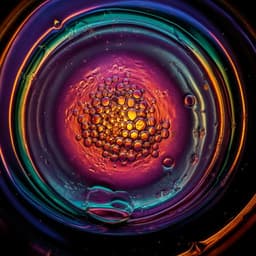
Chemistry
Impact of the aqueous corrosion induced alteration layer on mechanical properties of pharmaceutical glasses
Q. Zheng, X. Ma, et al.
This groundbreaking study reveals how aqueous corrosion influences the mechanical properties of pharmaceutical boroaluminosilicate glasses. Discover the surprising effects of water-related species on hardness and toughness, as researchers Qiuju Zheng, Xinlin Ma, Youze Ma, Jiaxin Yu, Yuanzheng Yue, and Hongtu He unveil insights for designing more resilient pharmaceutical materials.
~3 min • Beginner • English
Introduction
The outbreak of the global pandemic (COVID-19) in 2019 has affected billions of human lives, posed critical challenges to the health care system, vaccine manufacturers and pharmaceutical packaging industry. The good quality vaccine has been proven to reduce the risk of affecting the COVID-19 and thus save human lives. Nevertheless, without proper packaging and storage of vaccine throughout the entire supply chain, vaccination would be ineffective. Thus, it is extremely important to select proper packing materials of vaccine and pharmaceutical products. Among the primary packaging materials, borosilicate glasses are the most widely used material for packaging vaccines because of their high chemical durability, and more than 100 billion glass vials are produced and sold globally for various purposes in the past years. However, the emergence of environment-sensitive pharmaceutical products has tightened the requirements on their packaging. Thus, it is of great importance to understand the structure-property relationship of glass, and thereby develop the next generation of pharmaceutical glasses.
Generally, glass vials for pharmaceutical packaging require extremely high chemical durability, i.e., the release of the leachable ions to the vaccine should be avoided. Moreover, to increase the stability and lifetime of vaccine in the glass vials, the surface and subsurface damage of glass during manufacturing process should be avoided, and the contact load during the handing and transportation as well as packaging and storage process should be minimized to prevent potential contact damage on glass surface. Thus, both the mechanical properties and chemical durability of borosilicate pharmaceutical glasses should be greatly improved to increase the stability and lifetime of glass vials. Up to now, numerous studies have shown that the ion-exchange process is an effective approach to strengthen glass vials because such process can help reduce the probability of surface damage. In addition, the surface coating treatment has also been applied to improve the mechanical and chemical properties because the coating can help lower the coefficient of friction and cosmetic flaws. Those processes require high cost and precise facilities although they enhance the mechanical performances of glass. Recently we have noticed that little attention has been paid to the effect of surface modification by water corrosion on the mechanical properties of pharmaceutical glasses. It is well-known that even without physical contact, water molecules can react with silicate glass surface via hydration, hydrolysis, and/or ion-exchange. According to literature, such chemical reactions of silicate glass surface strongly affect the glass topography, surface chemistry, and nanomechanical properties. In the case of pharmaceutical glass, the water and glass surface interactions are also expected to occur under static conditions. Thus, without understanding the effect of water-induced surface corrosion on mechanical properties of pharmaceutical borosilicate glass, it would be impossible to design next generation pharmaceutical glass with superior mechanical properties.
In this study, the evolution of the mechanical properties of a low-boron pharmaceutical boroaluminosilicate (BAS) glass under various corrosion conditions were systematically studied upon nanoindentation, nanoscratch, as well as Vickers indentation tests. To mimic various leaching processes, all glass samples were placed into 50 mL deionized water (unbuffered) in a pressure steam sterilizer for 0 min to 90 min. After the leaching process, atomic force microscopy (AFM), Raman, TOF-SIMS, and sum frequency generation (SFG) spectroscopy were used to characterize the surface roughness, chemical structure, chemical element profile, and hydrogen bonding interactions of adsorbed water species of corroded glass, respectively. The nanoindentation, nanowear, and Vickers indentation tests were performed to reveal the evolution of mechanical properties with altering the glass surface by water corrosion. Based on the experimental results, the evolution mechanism of mechanical properties of borosilicate glasses is discussed.
Literature Review
Methodology
Glass composition: 68SiO2–2.2Al2O3–2.8B2O3–11.6Na2O–6.7CaO–8.6MgO (mol%), with 0.1 mol% SnO2 as fining agent. Preparation: Conventional melt-quenching using >99.5% purity reagents. Batch melted at 1600 °C for 2 h in alumina crucible; frit-quenched in water; dried, remelted 2 h; cast onto copper plate; annealed 2 h at Tg. Samples cut to 10×10×5 mm; all six faces polished (600–6000 grit SiC, then 1 µm and 80 nm diamond). Cleaned with distilled water and acetone (ultrasonication), dried 2 h.
Corrosion protocol: Static corrosion in 50 mL unbuffered deionized water using a pressure steam sterilizer at 121 °C for 0, 10, 30, 90 min (selected per pharmaceutical glass delamination stress testing protocol; slightly different from standard dissolution tests). Post-corrosion, pH recorded; leached ions in solution quantified by ICP-MS; equivalent altered glass thickness calculated by mass balance (Si and B).
Surface and subsurface characterization: ToF-SIMS (ION-TOF TOF-SIMS 5-100) for depth profiles and 3D distributions of modifiers (Na, Ca, Mg) and formers (Si, Al, B). Bi+ primary beam 30 keV, 50×50 µm2 analysis area (negative ions), 45° incidence; O2+ sputter 1 keV, 200×200 µm2, 45° incidence. Confocal micro-Raman (Renishaw InVia), 400–4000 cm−1, 2 cm−1 resolution, used to assess Si–O–Si band (~1050 cm−1) and OH stretching region (~3000–3700 cm−1); total water content in AL quantified from Raman calibration. Sum frequency generation (SFG) vibrational spectroscopy to probe hydrogen-bonding of adsorbed water: visible 532 nm and tunable IR (2.5–10 µm) overlapped; incidence 50° (vis) and 55° (IR); ssp polarization; measurements at 20±0.5 °C and 50% RH; oscillator strength ratios analyzed between ~3130, ~3270, and ~3390 cm−1 features.
Nanomechanical tests: Nanoindentation with Berkovich diamond tip (Agilent G200/Keysight). Target depth 300 nm; ≥15 indents per sample at 23 °C, 50% RH. Analysis via Oliver–Pharr to obtain nanohardness and reduced modulus (Poisson’s ratio of AL unknown, so reduced modulus used). AFM (SPI3800N, Seiko; Si3N4 tip radius ~8 nm, spring constant 40 N/m; tapping mode; 5×5 µm2 scans) to image residual imprints; samples annealed at 0.9×Tg for 2 h and re-imaged to separate densification and plastic flow per Yoshida method; volumes of densification (Va/Vd) and plastic flow (Vi/Vf) computed; recovery ratio VR = Va/Vi.
Nanowear (reciprocating scratch) tests: AFM with cubic-corner diamond tip (radius ~540 nm; cantilever ~254 N/m). Normal load 50 µN, 400 cycles, 4 µm sliding distance and 4 µm/s velocity per cycle; room conditions ~23 °C, 50% RH; ≥5 tests per condition. In-situ AFM imaging with Si3N4 tip; post-test annealing at 0.9×Tg for 2 h and re-imaging to quantify Va, Vi, VR.
Vickers indentation: HXD-1000TMC/LCD tester, load 3 N; Hν calculated as 1.8544P/d2; indentation fracture toughness KIC determined using KIC = ε·(E)1/2·P/c3/2 with ε=0.016, E elastic modulus of glass, and c crack length from indent center. ≥20 measurements per sample. Data availability and statistics: error bars reported as standard deviations with specified replicate counts.
Key Findings
- Corrosion-driven alteration layer (AL) growth: ToF-SIMS shows depletion of Na, Ca, Mg near surface; AL thickness increases with time: ~1.04 µm (10 min), ~1.07 µm (30 min), ~1.64 µm (90 min). ICP-MS indicates equivalent altered thickness increases with time; B-based thickness ~6× Si-based due to strong B hydration. Solution pH rises slightly from 7.00 to 7.19 (0–90 min).
- Water incorporation: Raman and ToF-SIMS show hydrous species (H+, OH, H2O) in AL increase with corrosion time; total water content in AL increases from ~0.03% to ~0.31% (0–90 min) and scales approximately linearly with AL thickness.
- SFG spectroscopy: Three OH features at ~3130, ~3270, ~3390 cm−1 increase with corrosion time; ratio of low-wavenumber (stronger H-bond) features to ~3390 cm−1 increases with water content, indicating stronger hydrogen bonding and facilitated stress-assisted hydrolysis.
- Nanoindentation properties: With water content rising to ~0.31%, reduced modulus decreases from ~83 to ~75 GPa and nanohardness from ~7.5 to ~6.4 GPa. Indentation depth increases from ~104 to ~121 nm; residual imprint volume from ~2.2×10−2 to ~3.4×10−2 µm3. Subsurface response: densification volume Va increases from ~1.3×10−2 to ~2.4×10−2 µm3; plastic flow volume Vi decreases from ~0.98×10−2 to ~0.89×10−2 µm3; recovery ratio VR increases from ~60% to ~73%.
- Nanowear behavior: Wear depth increases from ~9.8 to ~22.6 nm; wear volume from ~5.2×10−2 to ~11.3×10−2 µm3 with increasing water content. Post-anneal analysis shows Va increases from ~3.7×10−12 to ~9.4×10−12 mm3 and Vi decreases from ~1.8×10−12 to ~1.5×10−12 mm3; VR increases from ~70% to ~83%. Wear metrics scale nearly linearly with water content in AL.
- Macroscale mechanical properties: Vickers hardness decreases from ~6.5 to ~5.8 GPa as corrosion time increases; indentation fracture toughness KIC increases from 0.70 to 0.78 MPa·m1/2, attributed to enhanced subsurface densification propensity of the silica-like AL and reduced water transport to crack tips.
- Overall correlations: Increasing AL thickness and water content correlate with nearly linear decreases in hardness, modulus, and wear resistance, and with increased subsurface densification volumes and fracture toughness.
Discussion
The study addresses how aqueous corrosion-induced surface alteration layers (ALs) in pharmaceutical boroaluminosilicate (BAS) glass modify mechanical performance from nano- to macro-scales. Corrosion leaches network modifiers (Na, Ca, Mg) and some formers (B, Al), generating a silica-like AL that accumulates hydrous species. Enhanced water content and stronger hydrogen bonding at the surface, evidenced by Raman and SFG, facilitate stress-assisted hydrolysis of Si–O–Si during contact, explaining the reductions in nanohardness, reduced modulus, and wear resistance. Concurrently, the silica-rich AL exhibits greater propensity for densification under load. Post-anneal analyses separate densification from plastic flow, revealing increased densification volumes and recovery ratios with corrosion time for both indentation and wear. Despite reduced hardness, macroscale indentation fracture toughness increases, indicating that densification around the indent reduces residual tensile stresses and impedes radial crack growth; a densified near-surface region may also hinder environmental water access to crack tips. The work quantitatively links AL thickness and water content to mechanical metrics, establishing predictive trends useful for engineering tougher pharmaceutical glasses while accounting for surface corrosion effects.
Conclusion
The work establishes a direct, quantitative relationship between aqueous corrosion-induced alteration layers and mechanical properties of BAS pharmaceutical glass. Corrosion at 121 °C in water increases AL thickness and water content, leading to nearly linear decreases in nanohardness, reduced modulus, nanowear resistance, and Vickers hardness. Simultaneously, the silica-like AL promotes subsurface densification under indentation and wear, enhancing indentation fracture toughness. These insights are instrumental for designing next-generation pharmaceutical glasses with improved toughness and durability by controlling surface chemistry and corrosion-induced AL characteristics.
Limitations
- Mechanical property analysis used reduced modulus rather than true elastic modulus because the Poisson’s ratio of the alteration layer is unknown, introducing uncertainty in modulus comparisons.
- Corrosion testing conditions (unbuffered DI water at 121 °C in a pressure steam sterilizer) were selected based on a delamination stress testing protocol and differ slightly from standard glass dissolution/leaching protocols, which may affect direct comparison to other studies or service conditions.
Related Publications
Explore these studies to deepen your understanding of the subject.







